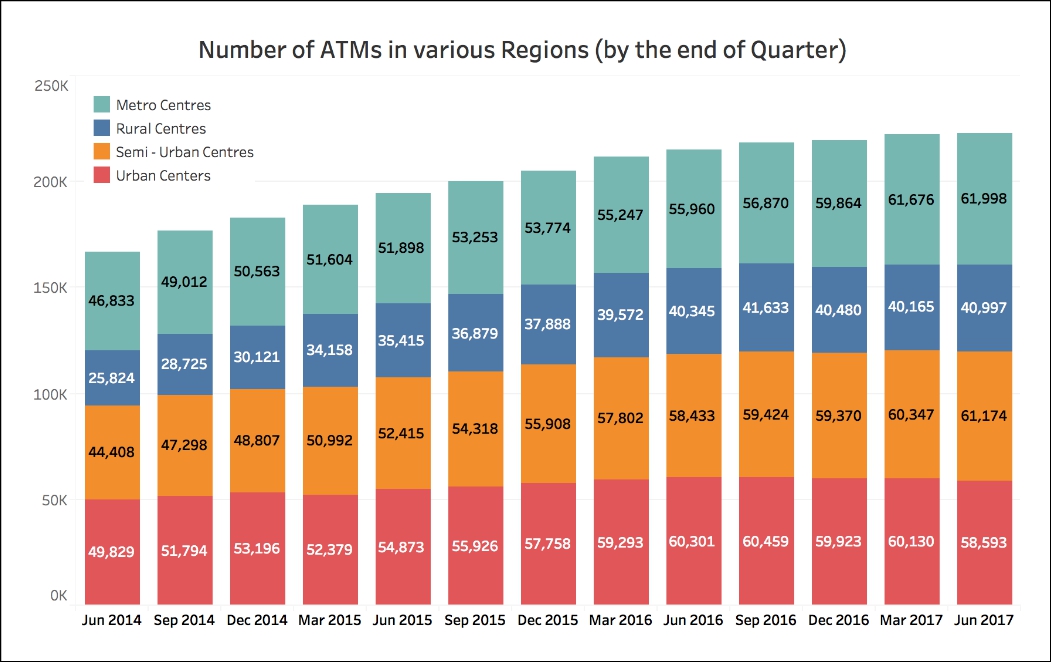[orc]ATMs have come under immense scrutiny in the period following demonetization last year. Data with the RBI reveals that the number of ATMs in rural centres as of June 2017 is less than what it was in September 2016.
ATMs have come under immense scrutiny post demonetization in November 2016. Data from the RBI indicates that the number of ATMs in rural areas has decreased starting September 2016 for two continuous quarters, the first such occasion since June 2014. The total number of ATMs in the country has increased by more than 33% between June 2014 and June 2017.
RBI classification into four different regions
The RBI classifies regions in the country into four categories based on the population. The various places in which bank branches & ATMs are located are classified into the following
- Rural:Population less than 10,000
- Semi-Urban: At least 10,000 & less than 1 lakh
- Urban: At least 1 lakh & less than 10 lakh
- Metropolitan:10 lakh and above
The above classification is followed both for the categorization of location of the bank branch as well as ATM.
Number of ATMs down in both Urban & Rural Centres
The total number of ATMs by the end of quarter in June 2017 was 2.23 lakh. Out of the 2.23 lakh, close to 62000 were in metropolitan areas, around 61000 in semi-urban areas, around 58500 in urban areas and the remaining 41000 in rural areas. The total number of ATMs by June 2017 has increased by more than 1/3rd compared to the 1.67 lakh ATMs by the end of June 2014.  The number of ATMs in metro centres has increased with each quarter from June 2014 and increased by more than 5000 between September 2016 & June 2017. Same is the case with the ATMs in semi-urban centres except for a slight blip in December 2016. The number of ATMs in urban areas increased continuously starting June 2014 and reached 60459 in September 2016 (except for a drop in March 2015). Thereafter, the number has come down to 58593 by June 2017. In the rural centres, the number of ATMs increased continuously up to September 2016 to reach 41633. It then decreased for two quarters continuously only to again increase during the quarter ending June 2017. Even as of June 2017, the number of ATMs in rural areas is less than what it was in September 2016. It has to be noted that the total number of ATMs in the country increased by over 2% between September 2016 & June 2017.
The number of ATMs in metro centres has increased with each quarter from June 2014 and increased by more than 5000 between September 2016 & June 2017. Same is the case with the ATMs in semi-urban centres except for a slight blip in December 2016. The number of ATMs in urban areas increased continuously starting June 2014 and reached 60459 in September 2016 (except for a drop in March 2015). Thereafter, the number has come down to 58593 by June 2017. In the rural centres, the number of ATMs increased continuously up to September 2016 to reach 41633. It then decreased for two quarters continuously only to again increase during the quarter ending June 2017. Even as of June 2017, the number of ATMs in rural areas is less than what it was in September 2016. It has to be noted that the total number of ATMs in the country increased by over 2% between September 2016 & June 2017.
Number of ATMs of some of the Public & Private Sector Banks comes down
In the rural centres, number of ATMs of the following banks has come down in June 2017 compared to September 2016. It is observed that the number of ATMs of major public sector banks (SBI etc.) and the white lable ATMs has increased while the number of ATMs of most other banks in rural centres has come down.
Banks whose ATM count in rural areas has decreased from September 2016 to June 2017
- Allahabad Bank
- Andhra Bank
- Bank of Baroda
- Bank of India
- Bank of Maharashtra
- Canara Bank
- Central Bank of India
- Corporation Bank
- Dena Bank
- HDFC Bank
- IDBI Bank
- Indian Bank
- Indian Overseas Bank
- Oriental Bank of Commerce
- Punjab & Sind Bank
- Tata Communications Payment Solutions Ltd. (White Lable ATMs)
- Karur Vysya Bank
- Syndicate Bank
Banks whose ATM count in rural areas has increased from September 2016 to June 2017
- State Bank group
- AGS Transact Technologies Ltd (White Lable ATMs)
- Axis Bank
- BTI Payments Pvt. Ltd (White Lable ATMs)
- City Union Bank
- Hitachi Payment Services Pvt. Ltd. (White Lable ATMs)
- ICICI Bank
- Jammu & Kashmir Bank
- Lakshmi Vilas Bank
- Punjab National Bank
- Union Bank of India


